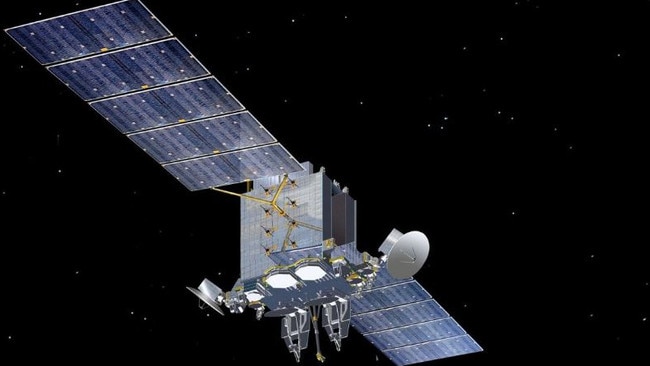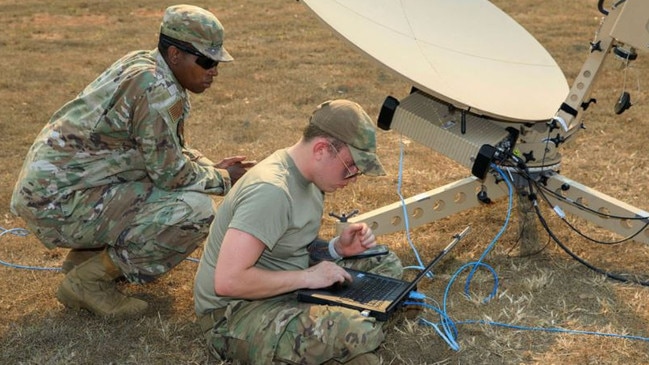Satellite down: nation’s biggest ever space program dumped over multibillion-dollar cost
A planned $7bn military-grade satellite communications system Labor gave the green light to 18 months ago will not go ahead, with no money in the Defence budget to pay for it.

The Albanese government is poised to cancel a planned $7bn military-grade satellite communications system it gave the green light to just 18 months ago because there is no money in the Defence budget to pay for it.
US defence giant Lockheed Martin was selected in April last year to deliver what was to be the nation’s biggest-ever space project – a hardened sovereign system of three to five satellites boasting the highest-level protection against cyber and electronic warfare attacks.
But The Australian can reveal the government will announce early this week – under the cover of the Melbourne Cup and the US election – that the project will not proceed.
It’s understood the government will blame the decision on multiple factors including rising costs and advances in technology that might offer a better system.
The system was to use geo-stationary satellites to create an uncrackable data network across the Australian Defence Force, providing communications and data links for its advanced fighter jets, naval assets and the army’s land forces.
The planned long-term budget for the project was put by the government at $5.2bn to $7.2bn, but it had approved only $150m to deliver it from its decade-long, $330bn capability investment plan.
The project, which was set to create 200-300 direct jobs, was to include multiple ground stations across Australia, an advanced satellite management system, and two new operations centres. Defence Minister Richard Marles’s office declined to comment on the decision when contacted by The Australian.

But a defence industry source said: “There is no money. There needs to be money to actually start the program.”
Another source said the planned budget for the project was insufficient for Lockheed Martin to deliver it.
The company beat Airbus, Northrop Grumman and Optus to be named preferred tenderer for the project, known as JP9102. It was yet to sign a contract for the work.
The government and Defence officials are set to be grilled over its cancellation during a Senate Estimates hearing this week.
Its axing follows the government’s decision last year to cancel a $1.2bn NASA-backed satellite program to monitor climate change, natural disasters and maritime threats.
The Australian has also previously revealed Defence spent $40m of taxpayers’ money on two Airbus satellites to provide surveillance, positioning and communications capabilities before killing off the project.
Defence head of space systems Air Vice-Marshal David Scheul said last year that the project would deliver the first Australian-controlled military satellite system covering the Indo-Pacific region.
“Currently across Defence there is up to 89 capabilities which depend on satellite communications,” he said.
“Once delivered, the new system will increase the resilience, agility and flexibility of Defence’s military satellite capability.”
Lockheed Martin has been the government’s go-to defence contractor in recent times, winning a slew of major contracts and selection to lead the government’s $74bn guided weapons and explosive ordnance program.
The company had promised a system “defined by its extensibility, agility and resilience”.
“We are bringing to bear all of Lockheed Martin’s company-wide capabilities as well as our commitment to supporting allied nations to provide an operationally proven system that meets mission needs in terms of coverage, capacity, resilience and extensibility of the constellation,” Lockheed Martin executive vice-president for space Robert Lightfoot said after the company was selected.

Australian Strategic Policy Institute senior analyst Malcolm Davis last year declared the satellite project represented the “beginning of a transition to resilient space capabilities for the ADF”, and would be one of the nation’s most important space projects.
“This will transform ADF communications, with the satellites providing high-bandwidth, high-speed digital connectivity across a vast region, from the central Indian Ocean to Solomon Islands, and from the Arctic to the Antarctic,” Dr Davis wrote in April 2023.
“This coverage will provide ADF operations across much of the Indo-Pacific region with robust command-and-control networks.”
Dr Davis wrote that the project could “firmly open the door to a larger role for Australia’s commercial space sector”. “The large satellites at the project’s core need to be seen as the beginning of a transition to resilient space capabilities for the ADF,” he wrote.
“The JP9102 satellites may, if they are based on open-architecture design or software-based systems, take advantage of future on-orbit servicing technologies that could extend their operational life and enhance their capabilities over time.”
The looming cancellation of the project is yet another blow to the government’s plans to re-arm the Australian Defence Force to prepare for a potential war with China, and comes as five of the navy’s six Collins-class submarines are out of action.
The Weekend Australian reported only one of the ageing boats is currently operational as corrosion problems, maintenance delays and long-running industrial action wreak havoc on the fleet’s availability.
There are also concerns that a fire at British defence giant BAE Systems’ yard in northern England will set back the AUKUS submarine program, which will be dependent on the UK’s submarine industry.
The government has insisted it is spending more than ever on new weapons, pledging an additional $5.7bn over the next four years in the last federal budget, and $50.3bn over the decade. But its capability investment plan has been heavily criticised for its opacity, offering few details on planned budgets and timelines.
Defence Industry Minister Pat Conroy last week announced a new factory to domestically produce 4000 missiles a year, saying it would propel the ADF into the “missile age”.
But critics warned the weapons slated for production had insufficient range and would arrive too late to make a difference to Beijing’s strategic plans for Taiwan.






To join the conversation, please log in. Don't have an account? Register
Join the conversation, you are commenting as Logout